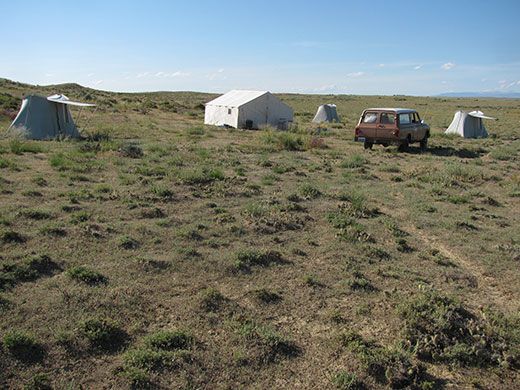Wyoming Dispatch #2: The Scene at Field Camp
Before digging, the paleobiologists must go through the arduous process of setting up camp
/https://tf-cmsv2-smithsonianmag-media.s3.amazonaws.com/filer/Wyoming-Dispatches-camp-site-tents-631.jpg)
Getting into the field can be difficult. A lot of details have to be worked out, and something always goes wrong. This year I flew to Denver and then drove up to Worland, Wyoming with my volunteer, Pam Hamilton. Wyoming looks greener than I have ever seen it—the result of a very snowy winter and a rainy, cool spring. We were supposed to meet Sarah Allen, a graduate student in biology at the University of Florida, at the Worland airport yesterday. Unfortunately, Sarah’s flight was canceled and she couldn’t reach Worland until today.
This morning Pam and I spent several hours pulling old camping gear out of storage in Worland—not exactly thrilling work! We hauled out tents to see which ones had survived 19 years of hot sun and wild Wyoming winds well enough to protect their occupants from another summer of the same. There isn’t one that hasn’t been glued, patched, re-zippered, or otherwise repaired, but there are four, plus one big cook tent, that are in good enough shape to do the job for another season.
After loading more camping gear than we thought would fit into my trusty 1970 Chevy Suburban, “Dino,” who lives at Stan’s Automotive every winter, and buying food and ice at the grocery in Worland, we headed off to find a place to camp. Pam hasn’t been in the field before, so she is surprised by how bumpy the dirt tracks are and that a 41-year-old truck like Dino is still able to get around in the badlands. I explain that Dino has more trouble with highways than with sagebrush, cactus and mudholes.
Finding a camping spot isn’t so easy—we looked for a place that is within a few miles of where we will be collecting, protected from strong west winds, away from any pools of water that breed mosquitoes, and flat and large enough to hold our tents. And we want a mountain view if we can get it! After an hour or two of searching we found a spot that looks like it will do and set to work pitching the big cook tent and the smaller sleeping tents. It was a pretty tiring afternoon in the hot sun, dragging the heavy canvas tents and other gear out of Dino, pounding stakes, pulling guy ropes and digging up a few cacti that happened to be in the wrong place.
We headed back into Worland to meet Sarah at about 6 – she finally managed to get here by a combination of airplane to Casper and bus to Worland. Everyone was tired enough that we decided to eat dinner in town, and after that we headed back out to the newly setup camp.
We got back about an hour before sunset, which is always the prettiest time of day in the badlands. The gold light on the hills around camp is dramatic, and the purple Bighorn Mountains loom off about 20 miles to our east, with a few puffy white clouds drifting above the more than 13,000-foot-high peaks. As the wind dies, we realize that this year has been so wet that the mosquitoes are everywhere. Time to get into the tents and get some rest. Tomorrow will be our first day of collecting.
Scott Wing is a research scientist and curator in the Smithsonian Institution’s Department of Paleobiology
/https://tf-cmsv2-smithsonianmag-media.s3.amazonaws.com/accounts/headshot/SLW_photo_-James_Kegley_for_Smithsonian.jpg)


/https://tf-cmsv2-smithsonianmag-media.s3.amazonaws.com/accounts/headshot/SLW_photo_-James_Kegley_for_Smithsonian.jpg)